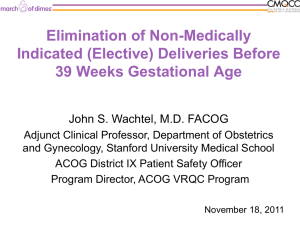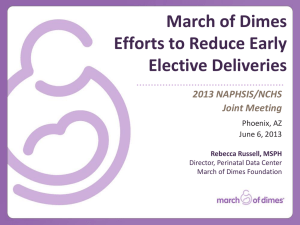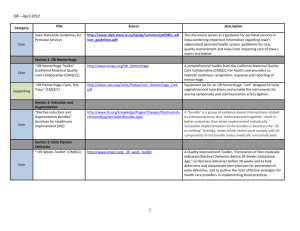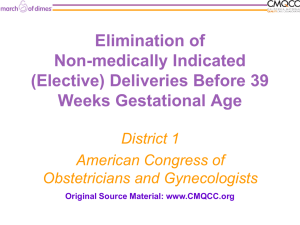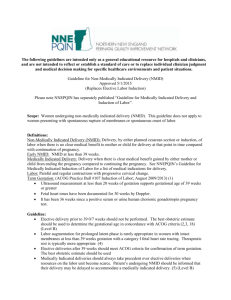Iowa Statewide Perinatal Initiative
advertisement
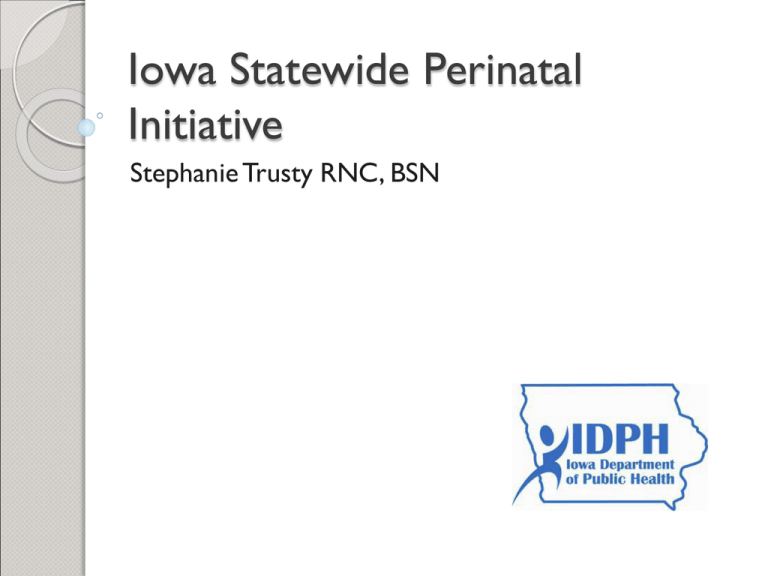
Iowa Statewide Perinatal Initiative Stephanie Trusty RNC, BSN Importance of Reducing elective delivery prior to 39 weeks Infants who have early term delivery (37 weeks 0 days to 38 weeks 6 days gestation) without a medical indication may experience the following: ◦ Increased morbidity ◦ Increased NICU admissions ◦ Increased neonatal deaths Compared with those infants delivered at equal to or greater than 39 weeks Late–preterm Brain Development March of Dimes MOD public awareness campaign ◦ If your pregnancy is healthy, it’s best if you baby is born at 40 weeks ◦ A baby’s brain at 35 weeks weighs only twothirds of what it will weight at 40 weeks ◦ In the last 6 weeks of pregnancy, the baby’s brain adds connections needed for balance, coordination, learning and social functioning. During this time, the size of the brain almost doubles Brain development cont. Babies born early have more learning and behavior problems in childhood than babies born at 40 weeks Feeding problems are more common because they can’t coordinate sucking, swallowing and breathing as well as full term babies RDS and apnea are more common Increased risk of SIDS NICU stay for both babies Vera - 6lbs 6 oz– RDS, UAC, jaundice, feeding problems Everett - 5lbs 1 oz– hypoglycemia, temp instability, feeding problems Twins born at 35 4/7 weeks Prevention of elective induction prior to 39 weeks a national quality metric Considered sub standard by ACOG ◦ National Quality Forum http://www.qualityforum.org/QPS/0469 Joint Commission ACOG Practice Bulletin Practice bulletin no. 107. Induction of Labor http://www.jointcommission.org/Perinatal_Care_Core_Measure_Set_Selection_Form/ March of Dimes, AAP, AWHONN Toward Improving the Outcome of Pregnancy III (66-68) http://www2.aap.org/sections/perinatal/pdf/TIOPIII.pdf Center for Medicare and Medicaid Services (CMS) Financial cost of early term deliveries Infants who were delivered electively between 37 and 39 weeks who are admitted to NICU had an average length of stay of 4.5 days By avoiding these NICU stays for early term elective deliveries the US health care system could save $1 billion annually. Clark SL, Frye DR, Meyers JA, et al. Reduction in elective delivery 39 weeks of gestation: comparative effectiveness of 3 approaches to change and the impact on neonatal intensive care admission and stillbirth. Am J Obstet Gynecol 2010;203:449.e1-6. Survey of Iowa Birthing Hospital Nurse Managers about elective deliveries prior to 39 weeks In 2011, IDPH, Iowa March of Dimes and CDC collaborated to: ◦ Estimate the availability of guidelines or policies with regard to elective inductions and elective cesarean sections. ◦ Assess hospital level knowledge and practice ◦ Identify gaps between evidence and practice ◦ Determine availability and need for training ◦ Make recommendations to guide development of educational interventions and providers tools. General Information about the survey 57.7% response rate 20-25 minute telephone survey 93% of those who completed the survey were supervisor or nurse managers ◦ 73% Level I ◦ 22% Level II ◦ 4% Level III 60% participating hospitals had less than 200 deliveries in 2011. Policy or guidelines 67% state they had a policy or guideline regarding elective inductions 40% had a policy or guideline regarding elective cesarean deliveries Compliance with the elective induction policy was reported most often as being monitored by internal audits Knowledge and Practice 64% incorrectly defined late preterm birth, 22% did not know the definition 37% incorrectly defined early term birth, 53% did not know the definition Need for training Staff training was offered on elective deliveries at 56% of the hospitals Training on elective deliveries was mandatory at 21% 71% of the respondents would like assistance in identifying opportunities for training on elective deliveries Gaps between evidence and practice Results suggest a gap between respondent knowledge and current evidence on the risks associated with elective deliveries. Survey Recommendations Have IDPH update Guidelines for Peinatal Services , 8th Edition with information on elective deliveries including: definitions for elective inductions and elective cesarean deliveries, specific criteria for determining gestational age, and examples of medical indications for induction Survey Recommendations Policy Development ◦ 1/3 hospitals had no policy on elective induction prior to 39 weeks ◦ 2/3 of the hospitals had no policy on timing of routine repeat C-sections Need for more education ◦ Statewide Perinatal Care Program http://www.idph.state.ia.us/hpcdp/statewide_perinatal_care.asp ◦ Healthy babies are worth the wait 39WeeksQI@marchofdimes.com Resources In 2010, The Joint Commission released a new set of perinatal quality measures that includes the reduction of non-medically indicated deliveries performed before 39 weeks gestational age. Available at: http://www.jointcommission.org/NewsRoom/NewsReleases/r_112009.htm Concurrently, the March of Dimes, in partnership with the California Maternal Quality Care Collaborative (CMQCC) and the California Maternal Child and Adolescent Division within the state Department of Health, created a toolkit entitled Elimination of Non-medically Indicated (Elective) Deliveries Before 39 Weeks Gestational Age. This toolkit outlines steps that hospitals can take to begin a quality improvement initiative to eliminate elective deliveries prior to 39 weeks. Download the toolkit from the Prematurity Prevention Resource Center at prematurityprevention.org. Resources MOD catalog #37-2229-07 Late-preterm brain development card 2/08 call 1-800-367-6630 http://www2.aap.org/sections/perinatal/pdf/TIOPIII.pdf References 1. Clark SL, Miller DD, Belfort MA, Dildy GA, Frye DK, Meyers JA. Neonatal and maternal outcomes associated with elective term delivery. Am J Obstet Gynecol 2009; 200:156.e 1-4. 2. Clark SL, Frye DR, Meyers JA, et al. Reduction in elective delivery 39 weeks of gestation: comparative effectiveness of 3 approaches to change and the impact on neonatal intensive care admission and stillbirth. Am J Obstet Gynecol 2010;203:449.e1-6. 3. Reddy UM, Ko CW, Willinger M. “Early” term births (37-38 weeks) are associated with increased mortality. Am J Obstet Gynecol 206;195:S202. 4. Iams J. for the Ohio Perinatal Quality Collaborative . A statewide initiative to reduce scheduled births without appropriate indication. Am J Obstet Gynecol 2009;201(suppl):s19






